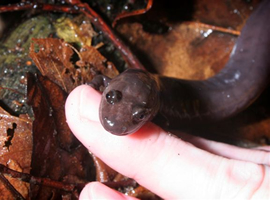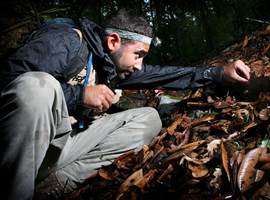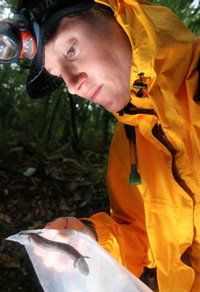Conservationists ‘Fish’ for Rare Salamander, a Breathing, Burrowing Environmental Indicator
By Chris Bryant

A drought-interrupting rain showers a trio of anglers, but they remain undeterred from their task – despite the weather and a complete lack of interest in catching fish.
Perched one-third of the way down the side of a deep ravine underneath a canopy of Southern Magnolia trees, one of the anglers, University of Alabama doctoral student J.J. Apodaca, deftly lowers his barbless, cricket-adorned hook into something other than water. What Apodaca is attempting to catch, you see, is trickier than landing a marlin from the deep sea. Instead, his focus is on one of our planet’s rarest creatures, the Red Hills Salamander.
Salamanders, as a whole, are among the most threatened groups of organisms in the world. “Amphibians, globally, are declining at incredible rates,” says Dr. Leslie Rissler, a conservation biologist at UA. “Many species are already extinct.”
That, in itself, is bad news for the Red Hills Salamander. Add in that this species’ only known locations, worldwide, are six Alabama counties, along with its federally threatened status, and its absence of close relatives (the only known species in its genus) and, well, it’s darn near depressing.
Rissler, Apodaca and Jim Godwin, of the Alabama Natural Heritage Program, along with Dr. Joseph Travis, of Florida State University, hope to assist the plight of the state’s official amphibian.
Through a state grant awarded to Rissler, the group is working to prioritize potential future land purchases in an effort to protect the habitat of the Red Hills Salamander and 22 other species of conservation concern within the area.
The first step down a multi-year path that could eventually lead to land deals is to learn more about the relationships between the salamanders and their environments, the amphibian’s genetic diversity and its geographical distribution.
That’s where the “fishing” comes in. Researchers hope to temporarily capture some 300 Red Hills Salamanders from their burrows, remove a one-quarter inch sample from their tails for genetic analysis, and release them back to their homes.
“We’re not allowed to dig them out of their burrows,” explains Rissler, a faculty member in UA’s College of Arts and Sciences. “That would be the most efficient way, but clearly, that would be destroying their habitat and would be illegal under the Endangered Species Act. Clearly, we wouldn’t want to do that. We want to do as little harm as we can.”
BILL DANCE WOULD BE PROUD

So, after locating the quarter-sized opening of a burrow along the woods’ leaf-covered floor, Apodaca shines the headlight he’s wearing into the opening. It’s not clear if anyone is home. However, within seconds of lowering the cricket, the salamander exhibits his presence, and his hunger, darting from the hole and grabbing the cricket.
With a left-handed snatch that would make Bill Dance proud, Apodaca jerks the fishing line, quickly removing the salamander from the burrow. After a brief scramble, Apodaca secures his moist-skinned friend.
Using a hand-held GPS navigation system, the UA student records his exact geographic location and temporarily places the salamander inside a clear, plastic bag where he takes measurements, jotting them down in a rain-dampened notebook. After the removed tail tip is stored in a vial of ethanol, the salamander, which will regenerate his severed extremity, is placed near his burrow and scurries back inside, seemingly undaunted by the experience.
A similarly successful scene is repeated on four instances while visitors watched – in between a few near misses and salamanders that either weren’t home or weren’t interested in a cricket snack.
IT’S ABOUT MORE THAN SALAMANDERS

The group uses phylogeography – a combined analysis of geography and genetics – and GIS niche modeling to predict the likelihood of the species being located in areas outside its known habitat. The salamanders, for instance, are found in areas where siltstone, a type of chalky clay, is exposed on the land’s surface. Through genetic analysis – which can, for example, provide population size estimates and reveal migratory patterns – the researchers will seek to identify land purchases most likely to maximize genetic diversity. Such diversity is important, Rissler says, in attempts to ensure the animal’s continued presence.
Much of the knowledge gained from the project will be applicable in efforts to sustain other animals of conservation concern in the area, Rissler says, including multiple endangered and threatened species. These range from speckled kingsnakes, to the gopher tortoise to two types of owls and four kinds of woodpeckers.
The significance of ensuring the long-term presence of salamanders and other amphibians is not limited to their own protection, Rissler says. As the salamanders breathe through their skins, they can be, in essence, early warning detectors for conditions going awry. Based on amphibians’ world-wide decline, such warnings are already alarming.
“Amphibians are important because they are sensitive to environmental change,” Rissler says. “They are sort of the canaries in the coal mine.”
Further Reading